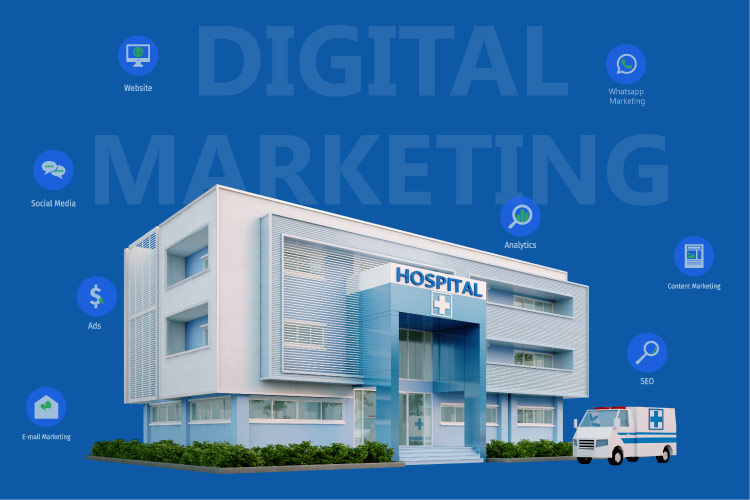
Digital Marketing for Hospitals: Strategies That Drive Results and Revenue
February 4, 2025Book A Free Demo
Latest Marketing Articles
Book A Free Demo
The healthcare landscape has shifted rapidly in recent years, with telemedicine playing a central role in reshaping how medical professionals interact with patients. Telemedicine’s rise reflects significant technological advancements and a growing preference among patients for more accessible healthcare. From expanding patient reach to reducing operational costs, telemedicine presents transformative benefits for both practices and patients.
In 2024, there have been over 116 million users of online doctor consultations worldwide, up from around 57 million in 2019.
Telemedicine allows healthcare providers to deliver medical consultations, diagnostic services, and follow-ups via digital platforms, usually through video conferencing, messaging, and remote monitoring devices. This shift enables patients to receive care from the comfort of their homes and allows medical practices to extend their services to remote or underserved areas. Notably, the global telehealth market is forecasted to reach $285 billion by 2027, driven by increased adoption in hospitals, clinics, and individual practices.
Wearable devices like heart monitors, blood glucose sensors, and smartwatches are set to become more central in telemedicine. These devices allow for continuous monitoring, offering real-time data that can alert providers to health changes and improve chronic condition management. For medical practices, integrating telemedicine with wearables creates opportunities for personalized care, reducing the need for frequent in-person check-ups and supporting a proactive approach to healthcare.
As more patient data is transmitted online, ensuring the privacy and security of medical information is paramount. Telemedicine platforms are increasingly adopting advanced encryption, multifactor authentication, and regular software updates to protect sensitive data. Implementing these security measures for healthcare providers fosters patient trust, a critical aspect of successful telemedicine adoption.
AI can streamline various aspects of telemedicine, from diagnosing minor health concerns to managing appointment schedules. AI-powered virtual assistants can screen patient inquiries and route them to the appropriate care provider, improving response times and reducing administrative workload. Medical practices that leverage AI in telemedicine can provide faster, more accurate care, enhancing patient satisfaction and operational efficiency.
Implementing telemedicine can have a profound impact on medical practices. Here are some of the primary advantages:
Telemedicine removes geographical limitations, allowing doctors and clinics to serve patients in distant locations, particularly in rural or underserved areas. By reaching more patients, medical practices can increase their patient base and fulfil a crucial role in improving healthcare access.
With telemedicine, overhead costs for physical space and in-office resources decrease, as virtual appointments require minimal equipment. This translates to significant cost savings for many practices while still offering quality care. Telemedicine also enables hospitals to optimize staff and resource allocation, making the entire system more efficient.
When patients can easily access healthcare services, they are more likely to attend follow-up appointments, ask questions, and adhere to treatment plans. Telemedicine enhances communication between patients and healthcare providers, supporting better long-term outcomes and patient satisfaction.
Telemedicine platforms often come with data tracking and analytics capabilities. This allows practices to assess patient outcomes, monitor appointment trends, and even identify areas for operational improvement. Healthcare providers can refine their approach with insights from telemedicine data to better serve their patients.
One of telemedicine’s primary advantages is convenience. Patients no longer need to travel or wait in crowded offices, saving time and reducing the stress associated with traditional appointments. This convenience makes healthcare more accessible, especially for patients with mobility issues or those in remote locations.
Telemedicine often reduces patients’ out-of-pocket costs, especially for travel, childcare, and time off work for appointments. Patients can connect with their doctors from anywhere, allowing them to seek timely care without additional financial burdens.
Telemedicine supports ongoing patient-provider communication, which can improve chronic disease management and ensure continuous care for patients in recovery. Regular telemedicine check-ins also enable patients to ask questions and receive guidance, reducing their risk of complications and hospital readmissions.
Once a practice has established its telemedicine services, the next essential step is telemedicine marketing. This involves promoting the new service to ensure current and potential patients are aware of the available virtual care options. Marketing can help patients understand the benefits and encourage them to use teleconsultations for routine visits and follow-up care. By leveraging telemedicine marketing strategies, practices can enhance patient engagement and build a reputation as an accessible, tech-forward healthcare provider.
Final Thoughts
Telemedicine’s future is bright, with promising advancements that will further integrate it into mainstream healthcare. By adopting telemedicine, medical practices and patients alike can experience a more convenient, efficient, and accessible healthcare journey. As digital tools continue to improve, telemedicine will undoubtedly become a cornerstone of modern healthcare, transforming how we think about patient-provider interactions.


